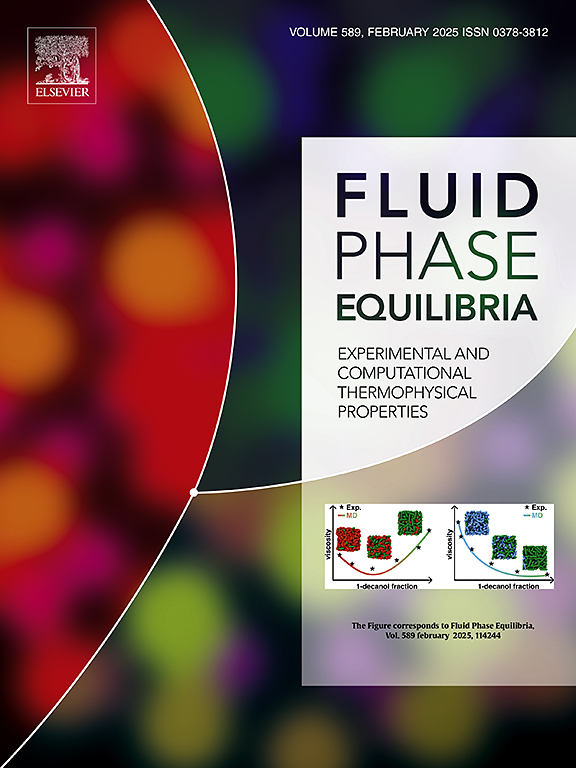Thermodynamic modelling of systems involved in natural gas dehydration with triethylene glycol using a group contribution association model
IF 2.8
3区 工程技术
Q3 CHEMISTRY, PHYSICAL
引用次数: 0
Abstract
Natural gas (NG) dehydration through absorption into Triethylene Glycol (TEG) is one of the most important applications in the NG industry. The optimal design of the TEG dehydration process requires a deep understanding of the thermodynamic behavior of mixtures containing TEG, water, hydrocarbons, and other compounds present in natural gas. In this work, the recently developed Universal Mixing Rule – Cubic Plus Association (UMR-CPA) group contribution equation of state (EoS) is extended to these systems. UMR-CPA combines the PR-CPA EoS with the UNIFAC group contribution activity coefficient model through the Universal Mixing Rules. Parameters for pure water, TEG and NG components were determined by accurately fitting vapor pressure, density and heat capacity data. For non-associating compounds, the model leads to overall deviations of 1.2 % in vapor pressures and 6.1 % in isobaric heat capacities. Water properties are also quite accurately described, with overall deviations of approximately 0.4 %, 1.2 % and 5.7 % in vapor pressures, liquid densities and isobaric heat capacities, respectively. The model was then applied to mixtures of water and TEG with gases and hydrocarbons by correlating the proper group interaction parameters. Very satisfactory results were obtained for both vapor-liquid and liquid-liquid phase equilibria in these systems, where also an adequate reproduction of the minimum of hydrocarbon solubility in water was noted. Finally, the UMR-CPA EoS was further validated through the prediction of the phase behavior of ternary systems including TEG and/or water and NG compounds. Very good predictions were achieved for the low TEG and water content in the vapor phase of the TEG-H2O-CH4 ternary system, with absolute deviations of around 0.05 and 23.26 ppm, respectively. Overall, the model yields accurate predictions, suggesting its suitability for designing the TEG dehydration process.
利用群体贡献关联模型建立天然气与三甘醇脱水系统的热力学模型
通过吸收三乙二醇 (TEG) 实现天然气 (NG) 脱水是 NG 工业中最重要的应用之一。要优化 TEG 脱水工艺的设计,就必须深入了解天然气中含有 TEG、水、碳氢化合物和其他化合物的混合物的热力学行为。在这项工作中,最近开发的通用混合规则-立方加联结(UMR-CPA)组贡献状态方程(EoS)被扩展到这些系统中。UMR-CPA 通过通用混合规则将 PR-CPA EoS 与 UNIFAC 群体贡献活动系数模型相结合。通过精确拟合蒸汽压力、密度和热容量数据,确定了纯水、TEG 和 NG 成分的参数。对于非缔合化合物,该模型导致的蒸汽压总体偏差为 1.2%,等压热容总体偏差为 6.1%。水的性质也得到了相当准确的描述,蒸气压、液体密度和等压热容的总体偏差分别约为 0.4%、1.2% 和 5.7%。然后,通过关联适当的基团相互作用参数,将该模型应用于水和 TEG 与气体和碳氢化合物的混合物。在这些系统中,气-液相和液-液相平衡都得到了非常令人满意的结果,同时还注意到碳氢化合物在水中的最小溶解度也得到了充分的再现。最后,通过预测包括 TEG 和/或水和 NG 化合物在内的三元系统的相行为,进一步验证了 UMR-CPA EoS。对 TEG-H2O-CH4 三元体系气相中较低的 TEG 和水含量进行了非常好的预测,绝对偏差分别约为 0.05 和 23.26 ppm。总体而言,该模型能得出准确的预测结果,表明其适用于设计 TEG 脱水过程。
本文章由计算机程序翻译,如有差异,请以英文原文为准。
求助全文
约1分钟内获得全文
求助全文
来源期刊

Fluid Phase Equilibria
工程技术-工程:化工
CiteScore
5.30
自引率
15.40%
发文量
223
审稿时长
53 days
期刊介绍:
Fluid Phase Equilibria publishes high-quality papers dealing with experimental, theoretical, and applied research related to equilibrium and transport properties of fluids, solids, and interfaces. Subjects of interest include physical/phase and chemical equilibria; equilibrium and nonequilibrium thermophysical properties; fundamental thermodynamic relations; and stability. The systems central to the journal include pure substances and mixtures of organic and inorganic materials, including polymers, biochemicals, and surfactants with sufficient characterization of composition and purity for the results to be reproduced. Alloys are of interest only when thermodynamic studies are included, purely material studies will not be considered. In all cases, authors are expected to provide physical or chemical interpretations of the results.
Experimental research can include measurements under all conditions of temperature, pressure, and composition, including critical and supercritical. Measurements are to be associated with systems and conditions of fundamental or applied interest, and may not be only a collection of routine data, such as physical property or solubility measurements at limited pressures and temperatures close to ambient, or surfactant studies focussed strictly on micellisation or micelle structure. Papers reporting common data must be accompanied by new physical insights and/or contemporary or new theory or techniques.
 求助内容:
求助内容: 应助结果提醒方式:
应助结果提醒方式:


